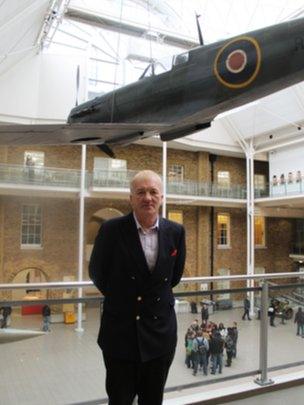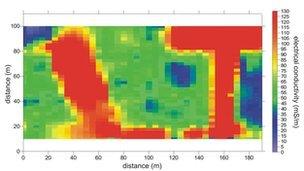Search for missing Spitfires in Burma due to begin
- Published

David Cundall is hoping his 16-year hunt for missing Spitfires will soon be over
Work is due to start in January to unearth dozens of missing British Spitfires believed to have been buried in the Burmese jungle at the end of World War II.
What began as one man's quest to discover the truth of claims that unused unassembled aircraft were packed into crates and buried by the RAF in Burma in 1945 has captured the imagination of a war games company and a team of experts, including archaeologists and scientists.
They all gathered at the Imperial War Museum in London on Wednesday to outline their plans for the dig, due to get under way in the New Year.
It is thought 36 planes could be lying undiscovered in Mingaladon - one of three sites where it is believed as many as 60 Spitfires in total may be located.
Farmer and aviation enthusiast David Cundall, from Lincolnshire, is spearheading the dig, having spent 16 years and thousands of pounds already researching the project.
"I have been flying aeroplanes for 45 years and been digging up sites looking for military aircraft for 36 years. It's in my blood," he said.
After hearing the story of the buried planes, he sought out eyewitness accounts from American and British service personnel, as well as local people, who told him how scores of brand new Mark XIV Spitfires were buried in 1945 under the orders of Lord Mountbatten.
He said one local Burmese man recalled how, as a 15-year-old, he and his father had transported timber that had been used as the Spitfires were buried. The local man led him to the spot where the planes had been put.
Clues found
But aside from these eyewitnesses, all the experts have uncovered so far are tantalising signs of increased electrical conductivity found in two areas during an electromagnetic survey.
This could in turn indicate the presence of buried metal at around 10 metres deep.
Project archaeologist Andy Brockman accepted the search for the aircraft shipped in for the war with Japan could turn into a wild goose chase, but added: "It could also be one of the most fascinating discoveries in aviation archaeology."

An electromagnetic survey of the site in Burma
He likened the project to a crime scene saying his interest is in converting speculation and rumour into "facts on the ground".
"We have no conclusive evidence about how the Spitfires arrived in Burma - or if they arrived at all. What we are here to do is resolve that."
And the mystery persists as to why the planes might have been buried.
Mr Brockman said the idea that the Spitfires were hidden to stay out of enemy hands was not necessarily correct because Japanese forces would have not been in a position to use them at that point.
But if the planes are discovered packed into crates, this would be "unprecedented", he added.
He is confident if the Spitfires are found it will be possible to fly them again. However it remains to be seen what condition the planes might be in, having been underground for 67 years.
And if they are discovered to be salvageable, some may be back in the UK as early as spring 2013.
But restoring the Spitfires to their former glory would come at a cost - up to three years to rebuild each machine at a cost of £2 to £3 million, according to one aircraft restoration company.
Wargaming.net, which is providing financial support for the hunt, is excited by the prospect of the find.
Chief executive Victor Kislyi, said: "We are looking for these beautiful war machines hidden somewhere in the tropical jungle. It sounds like Indiana Jones.
"We hope we can see a squadron of Spitfires flying over London."
Mr Cundall will see a financial reward if any Spitfires do emerge, with his share of the discovery pegged at 30% of any money raised. His agent and the Burmese government will share the remainder, with the government's 50% share expected to be up for sale.
Meanwhile he said he had letters from the British government releasing any ownership rights.
Downing Street welcomed the latest moves, after Prime Minister David Cameron met Burmese President Thein Sein earlier this year.
A spokeswoman said: "There was a heritage agreement then about the Spitfires being restored and hopefully gracing the skies of Britain again."
But she added the British government was not involved in any commercial arrangements regarding the dig and did not claim any rights to the Spitfires.
'Made for flying'
As for Mr Cundall he said: "All my share is going back to the UK. My interest is in restoring them to flying condition."
His enthusiasm for the project is clear.
RAF servicemen are thought to have buried Spitfires in a Burmese field at the end of the war
"My own personal view is that Spitfires are made for flying and not for being in museums. I would love to fly one of these myself."
Mr Cundall has had to overcome many hurdles to realise his ambitions, repeatedly visiting Burma while the country was run by a military junta and the subject of international sanctions.
He relentlessly pursued the project, finally signing a contract last month with the Burmese authorities to excavate three sites. He says one of his team did put a camera down a borehole previously and saw what they thought was an aeroplane but there was nothing conclusive.
Others have already searched fruitlessly. Mr Cundall mentions an Israeli team who found nothing.
But he says he continues to have the full support of his wife and family for what has been his long-abiding "passion".
The arduous dig which will involve examining layer by layer of soil will begin in earnest in January.
When asked what his reaction would be if they actually found any Spitfires, he said it would be like when the archaeologist searching for Tutankhamun's tomb peered into the site and was asked if he could see anything to which he replied "Yes, wonderful things".
"That's what I'll say, I can see wonderful things, " he said.
- Published28 November 2012
- Published28 November 2012
- Published10 November 2011
- Published3 March 2011